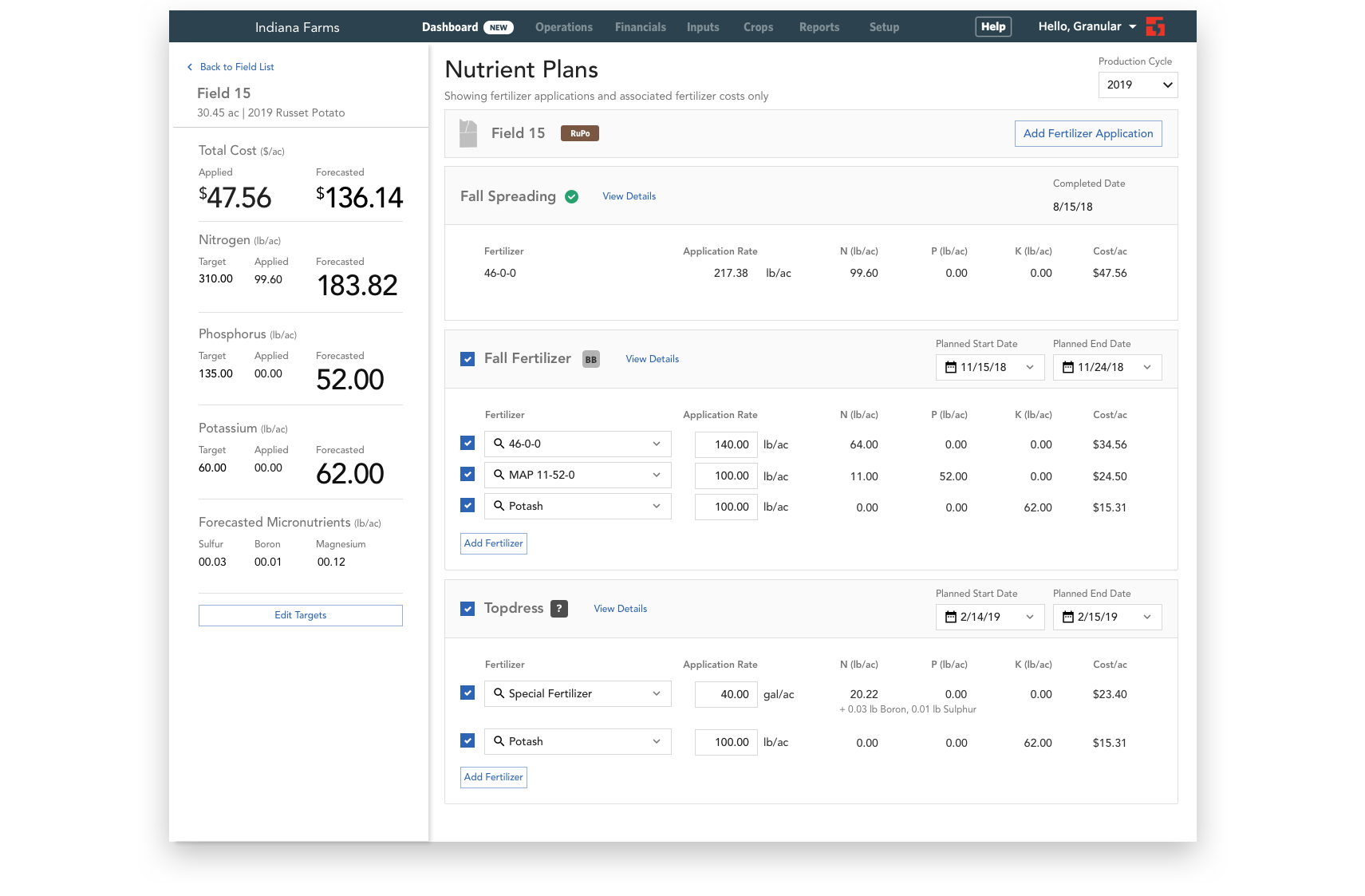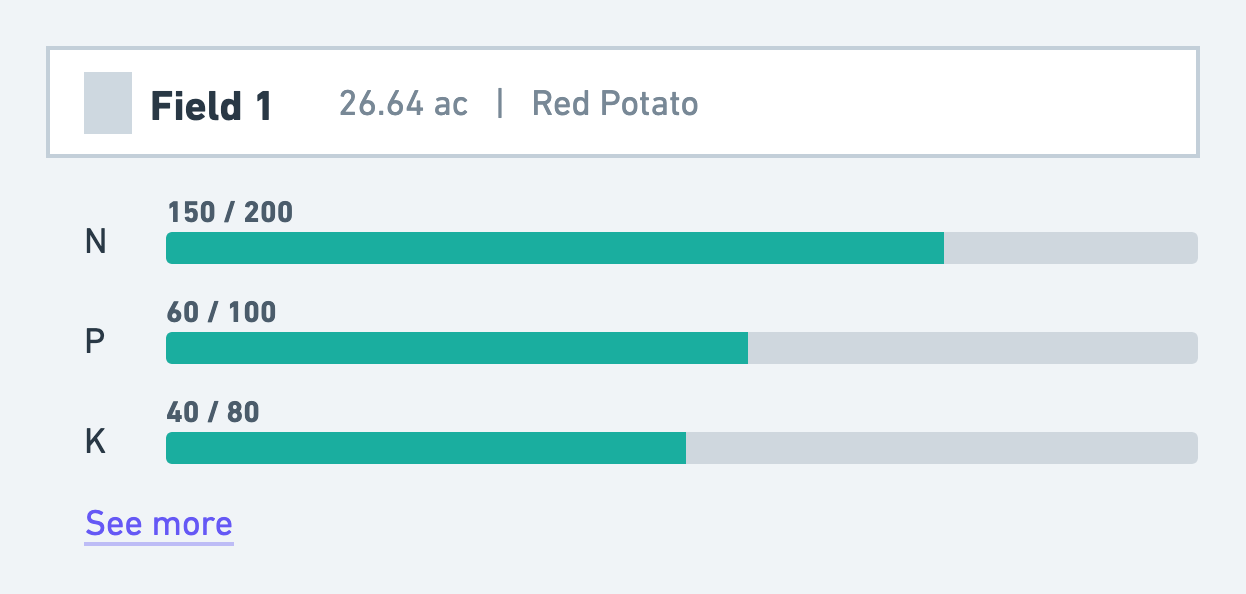Helping farmers plan and keep track of nutrients in their fields
What
Nutrient planning and cost analysis experience for Granular Business
Who
I worked closely with a Product Manager and Engineering Lead.
When
2019
Granular Business is farm management software that helps farmers be more efficient and profitable by capturing and analyzing field activity.
Applying fertilizers to crops is an essential part of a farm’s work. Our team built the Nutrient Plans experience in 2019 to help farmers evaluate fertilizer options while understanding nutrient breakdowns and associated costs - taking cost analysis to the next level.
The Problem
How can we enable potato farmers to plan and keep track of nutrients that have been applied to their fields?
If a farmer fails to apply enough nutrients to a field, it may lead to suboptimal yield. Conversely, applying too much is wasteful, costly, and harmful to the environment.
Because of this, farmers want to apply just the right amount of nutrients to their fields to maximize yield and minimize costs.
Granular Business already tracks field activity, including fertilizer applications, but doesn’t break down fertilizers into specific nutrients (such as nitrogen or potassium). Currently, our users do a mental calculation or maintain separate records to figure out how much of each nutrient is in the fertilizer. This duplication of efforts was extremely painful for all of our users, but especially to those who grow heavily managed crops such as potatoes.
Discovery Research
Visiting a potato farm in Wisconsin
The farmer dug these red potatoes out of the ground for us to see!
To better understand the needs of our customers, I visited several potato farms, examined current solutions, and reviewed competitors in the industry. We learned that the needs and goals around nutrient tracking change throughout the year.
Understanding User Pains
Currently, most farmers maintain nutrient records on paper or in software such as Microsoft Word or Excel. This is painful because...
Manual work involved in calculating nutrient amounts and their associated costs is tedious and error-prone
Difficulty in sharing records with team members and stakeholders on and off the farm
Granular Business already tracks fertilizer applications but doesn’t break it down by nutrients, so doing this in another system feels like a duplication of efforts
Why is nutrient planning so hard?
Your agronomist suggests you apply 80 lbs of nitrogen on Field A, spread out across 5 applications throughout the year. You plan to use UAN 32-0-0, a fertilizer product that contains 32% Nitrogen. How of that product do you need to meet your 80 lbs target? How much would that cost, by acre and by field? If you swapped with another fertilizer product, would it be cheaper? Does that also meet your targets for potassium, phosphorus and other nutrients? (Now multiply all of that work by 50 - 200 for the number of fields that a farmer typically operates on).
These sorts of questions are difficult to answer without a better way to manage nutrient planning.
Early Design Explorations
I played around with different ways of comparing how much of each nutrient is planned to be applied vs. has already been applied vs. a “target”, the recommendation given to farmers by their agronomic advisors.
Table format
Progress bars
In this wireframe prototype, users see each planned or actual task as a card. Each card displays the fertilizer product(s) used in the task, as well as a breakdown of nutrient amounts and cost. For planned tasks, users can select and unselect checkboxes to indicate whether they want to include or exclude a product, allowing them to play with different product and rate combos to see how it effects nutrient amounts and cost.
At the bottom, users can enter overall nutrient targets and see summaries of forecasted, actual, and planned amounts.
Getting User Feedback & Iterating
Our conversations with customers after showing them prototypes were largely positive and helped us to clarify open questions around which nutrients they wanted to track, and what time of year they would use the experience.
“You’re on the right track, I would absolutely use this.”
“I would use this mid-winter for planning, later on to see what I’ve applied, and after rain.”
“I might review it at the end of the year to compare to yield.”
One area that users wanted to see more of was scenario planning. Farm managers wanted to quickly switch out fertilizer products or amounts applied to see how it may affect their bottom line. I also learned that nutrient targets don’t generally change much since they are based on soil sampling results.
Final Design
The final design we went with was an easy scenario planning experience that compared forecasted nutrient amounts to “target” amounts. By focusing on forecasted fertilizer amounts instead of planned amounts or actuals, this experience is relevant and useful at all times of the crop cycle.
Release & Outcomes
After a brief beta period, we released the Nutrient Planning experience to all customers in June 2019. Here are some of the feedback we have received so far:
“This is beneficial to us and will help me keep track of where we are at with our applications. I can look back easily and see what we did last year to know if we can afford another application this year on the same field. I’m the type that likes to plan, and would rather brace the checkbook in advance than look back and wonder why we spent all this money after the fact.”
“When I showed [potential customer] the example on Field 1 of how it is currently 10lbs of nitrogen over target, and how we can “play” with the next application and reduce it by $3/acre, he said: Yeah, $3-$4/acre does not seem like a lot, but on 1000 acres that really adds up.”
“That nutrient plans is a nice addition. It’s nice to see a quick report card of what’s on the field from a nitrogen standpoint, instead of trying to track it through a spreadsheet. ”
“Just got off a call with a [competitor] user that is about 6,500 acres. He has looked at us a few times but always felt we were the same as [competitor], just priced higher...well, his tone changed after seeing some of the new functionality we have come out with in 2019. Nutrient Plans was what really caught his attention. While he just renewed last month with [competitor] so he wants to wait the rest of this season out, he wants us to give him a call in winter to talk about changing over.”








